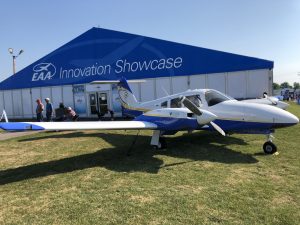I attended the EAA Innovation Forum at Oshkosh. Note the Piper Seminole, certified in 1978 with engines dating to 1955, parked in front of the adjacent “Innovation Showcase”:
Pat Anderson, a professor at Embry-Riddle, pointed out that the early jets were re-engined prop airframes. It took a few years before the wings and fuselage caught up to the new powerplant. Similarly, he thinks that electric propulsion will result in aircraft that bear little resemblance to today’s single-engine piston airplanes.
Mike Sennett, an executive at Boeing, proceeded to talk about how 800,000 new pilots will be needed to staff the 42,700 new airliners predicted for delivery over the next 20 years (the fleet will double from 2017-2037 with huge growth in Asia). Mr. Sennett noted that aviation went from being perceived as high risk in the 1920s and 1930s to being super safe now (40,000 car-related deaths per year in the U.S. versus 0 in a typical year from airliners). [One wag, noting all of the “WomenVenture” T-shirts that had been handed out to pilots identifying as female, said “Now that airline flying is risk-free they want to get women into these jobs.”] Sennett sees a lot of growth opportunity in air freight. Currently only 1 percent of freight goes by air (35 percent by value). Boeing’s big drives are autonomy, AI, and electric propulsion. Maybe those 800,000 new pilots will turn into 1 new computer program?
After the two gray-haired guys got off the stage, a bearded California hipster began speaking. Adam Warmoth, of Uber Elevate, looked to be about 25. He explained that, within 25 years (i.e., by the time he reaches “GA age”), 6 billion people will be living in cities. The result will be that transportation grinds to a halt. People will spend hours in traffic if they want to go somewhere that is not within walking distance. Uber is going to fix all of this, at least for customers that can spend about $100 per trip, with electric aircraft that can make 25-mile trips within monster cities such as Los Angeles. The goal is a 150 mph aircraft that can hold 4 paying customers. Uber is designing common reference models that manufacturers can grab and use. Their goal is to be up and running in LA by 2023(!).

10 years after the quad copter boom, it’s become clear that those pilots will always be in employed, still translating verbal commands from ATC to control movements. Only more of the lever pulling, dial watching, & checklists are going away.
I’d like to see Blade Runner flying cars in my lifetime.
But as for congested cities that should be a solveable problem using public transport, self driving cars and maybe even bicycles.
Here are a couple of charts reminding us just how ineffecient cars actually are
https://twitter.com/SonyKapoor/status/1027796785597575168
General Aviation has still not had a Henry Ford.
So what would an ideal electric airframe look like? Obviously, you don’t need to hang a giant chunk of metal on the front anymore. Heavy batteries can be put wherever it makes sense , and multiple propellers or fans become practical.